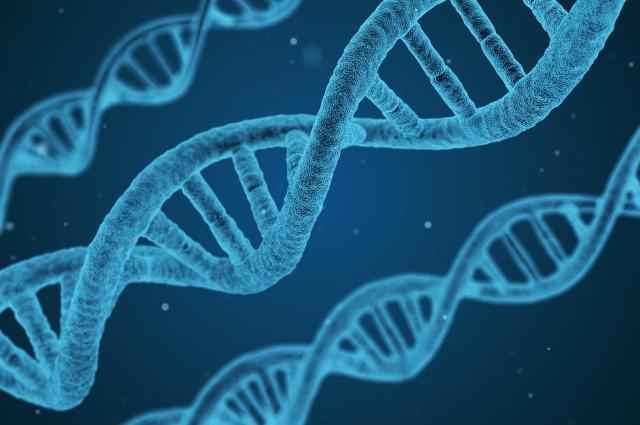
Image by Arek Socha from Pixabay
Recent research from Sinai Health has unveiled surprising findings about certain DNA components known as transposons. These mobile elements within the genome play a crucial role in the early stages of human development rather than the traditional belief that genes alone drive this process.
A Shift in Understanding
This discovery challenges prior assumptions about transposons which have long been considered mysterious parts of the genome. Previously, these sequences were not thought to be directly involved in development. However, the study reveals their significant influence on how human cells grow, develop and even how diseases may emerge.
Transposons: More Than Genomic Parasites
Dr. Miguel Ramalho-Santos, the senior co-author of the study and a Senior Investigator at the Lunenfeld-Tanenbaum Research Institute, emphasizes a new perspective on transposons. He explains that these elements have been related to viruses with the primary role of self-replication. Yet, this research shows that transposons are not merely parasitic but are, in fact, essential for the normal progression of human development.
Key to Early Development
Published in the journal Developmental Cell, the study emphasizes the importance of transposable elements in early embryonic development. These DNA components help ensure that human embryonic cells follow their proper course of development by preventing them from degenerating to an earlier state. This research has expanded our understanding of the genome by highlighting the active and necessary role of transposons in human development by reshaping how we view these once-overlooked elements.
Role of LINE-1 Transposable Elements in Early Human Development
The study which was published in Developmental Cell, sheds light on the critical role of transposable elements by specifically LINE-1 (long-interspersed nuclear element-1) in human embryonic development. These elements play a significant part in ensuring that cells develop normally without regressing to an earlier stage.
The Prevalence of LINE-1 in the Human Genome
LINE-1 elements are surprisingly abundant by making up about 20% of our genetic material compared to the mere 2% that is comprised of our genes. Some of these elements have the ability to move and replicate within the genome by inserting themselves into new locations. This characteristic has earned them the label of "selfish DNA" because their movement can interfere with normal gene functions.
Previous Assumptions About LINE-1
For many years, scientists believed that LINE-1 elements were primarily harmful. Their ability to spread independently within the genome often led to disruptions that were linked to various diseases including haemophilia, neurological disorders, and cancer. This gave them a reputation for causing more harm than good in human biology. However, this new research suggests that rather than being purely detrimental, LINE-1 elements play an essential role in the early stages of human development. This discovery is reshaping the way scientists understand these complex DNA components.
Dr. Juan Zhang's Research on LINE-1 RNA in Early Embryos
Introduction to LINE-1 RNA in Early Development Dr. Juan Zhang, a senior co-author and postdoctoral fellow that led a ground-breaking study investigating the role of LINE-1 RNA in early embryonic development. She found it particularly intriguing that these RNA messages were highly abundant in early-stage embryos. LINE-1 RNA, recorded from active regions of the genome ; indicates that LINE-1 elements are switched on during the critical phases of development.
The Paradox of LINE-1 Activation Dr. Zhang raised an important question: "If transposons are considered harmful and risky, why do we see them active in the embryo during its earliest stages?" This query is especially relevant because any harmful insertion of transposons into the genome at such a delicate stage could propagate throughout the development of the individual. This paradoxical presence of transposons sparked further investigation.
Inhibition of LINE-1 and its Effects on Embryonic Stem Cells, In her experiments, Dr. Zhang inhibited LINE-1 expression in cultured human embryonic stem cells (ESCs). Surprisingly, this caused the cells to revert to a more primitive state—the 8-cell stage. At this stage, all eight cells are identical and totipotent, meaning they have the potential to develop into both the embryo and the placenta. As ESCs progress beyond this stage, they remain capable of forming foetal cells but gradually lose their ability to contribute to the placenta, a vital structure that provides nutrients from the mother.
LINE-1's Role in Organizing DNA Further experiments revealed that LINE-1 RNA serves as a scaffold within the 3D space of the cell's nucleus. Specifically, LINE-1 helps position chromosome, which is crucial for the 8-cell stage, into a gene-silencing region of the nucleus. This process ensures that the embryo can transition smoothly into later developmental stages.
Dr. Zhang's research highlights the complex role that LINE-1 RNA plays in early embryonic development. While transposons like LINE-1 are typically seen as dangerous, their presence and activity in the early embryo appear to be crucial for proper progression through developmental stages.
Dr. Zhang's research highlights a novel role for LINE-1 elements in embryonic development by indicating they regulate gene expression at a pivotal moment when cells begin to specialize. This finding suggests that LINE-1's involvement is not merely incidental but a significant evolutionary mechanism that supports developmental processes. Unlike their typical behaviour of causing mutations through genomic mobility, in this context, LINE-1 elements play a crucial role in fostering proper growth during early human development.
This fundamental research on LINE-1 elements has significant implications for fertility treatments and the use of stem cells in regenerative medicine. By revealing LINE-1's novel roles in gene regulation during early development, it opens avenues for exploring its involvement in various disease contexts including neurological disorders and cancer. Understanding these mechanisms could enhance therapeutic strategies and improve outcomes in both fertility treatments and regenerative therapies, stressing on the importance of LINE-1 beyond its previously recognized roles.
. . .
References:
